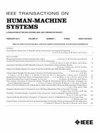Assessment of Upper-Body Movement Quality in the Cartesian-Space is Feasible in the Harmony Exoskeleton
IF 3.5
3区 计算机科学
Q2 COMPUTER SCIENCE, ARTIFICIAL INTELLIGENCE
引用次数: 0
Abstract
To determine the most effective interventions for poststroke patients, it is imperative to monitor the recovery process. Robotic exoskeletons' built-in sensing capabilities enable accurate kinematic measurement with no additional setup time. Although position sensors used in exoskeletons are accurate, a mismatch between the robot's and the human's joints can lead to inaccurate measurements. In addition, the robot's residual dynamics can interfere with human's natural movements and the kinematic metrics assessed in the robot would not be representative of the human's movement in free-motion. So far, the accuracy of robotic exoskeletons in assessing upper-body kinematics has not been verified. The bilateral upper-body Harmony exoskeleton has features favorable to minimize joint misalignments and the robot's residual dynamics. In this study, we examined Harmony's ability to accurately assess Cartesian-space kinematic parameters associated with the wearer's movement quality. We analyzed data collected from eight healthy participants that executed point-to-point movements with and without the presence of the robot and at fast and slow speeds. Ground truth was acquired with an optical motion capture, and we extracted the kinematic parameters from the measured data. The results suggest that Harmony can accurately measure kinematic parameters associated with movement quality, and these parameters could appropriately reflect wearer's natural movements at a slow speed. Therefore, Harmony could aid the evaluation of the effectiveness of different interventions, which is more sensitive and efficient than currently adopted clinical outcomes. This allows for individualization of a treatment plan and a detailed follow-up.在和谐外骨骼中评估笛卡尔空间中的上半身运动质量是可行的
为了确定对脑卒中后患者最有效的干预措施,有必要监测恢复过程。机器人外骨骼的内置传感功能可以实现精确的运动测量,无需额外的设置时间。尽管外骨骼中使用的位置传感器是精确的,但机器人和人类关节之间的不匹配可能导致测量不准确。此外,机器人的剩余动力学会干扰人的自然运动,并且机器人评估的运动学指标不能代表人在自由运动中的运动。到目前为止,机器人外骨骼在评估上半身运动学方面的准确性尚未得到证实。双侧上肢Harmony外骨骼具有减少关节错位和减少机器人残留动力学的特点。在这项研究中,我们检查了Harmony准确评估与佩戴者运动质量相关的笛卡尔空间运动学参数的能力。我们分析了从8名健康参与者收集的数据,他们在有和没有机器人的情况下以快和慢的速度进行点对点运动。利用光学运动捕捉技术获取地面真值,并从实测数据中提取运动参数。结果表明,Harmony可以准确地测量与运动质量相关的运动学参数,这些参数可以适当地反映佩戴者在慢速下的自然运动。因此,Harmony可以帮助评估不同干预措施的有效性,这比目前采用的临床结果更敏感和有效。这允许个性化的治疗计划和详细的随访。
本文章由计算机程序翻译,如有差异,请以英文原文为准。
求助全文
约1分钟内获得全文
求助全文
来源期刊

IEEE Transactions on Human-Machine Systems
COMPUTER SCIENCE, ARTIFICIAL INTELLIGENCE-COMPUTER SCIENCE, CYBERNETICS
CiteScore
7.10
自引率
11.10%
发文量
136
期刊介绍:
The scope of the IEEE Transactions on Human-Machine Systems includes the fields of human machine systems. It covers human systems and human organizational interactions including cognitive ergonomics, system test and evaluation, and human information processing concerns in systems and organizations.
 求助内容:
求助内容: 应助结果提醒方式:
应助结果提醒方式:


